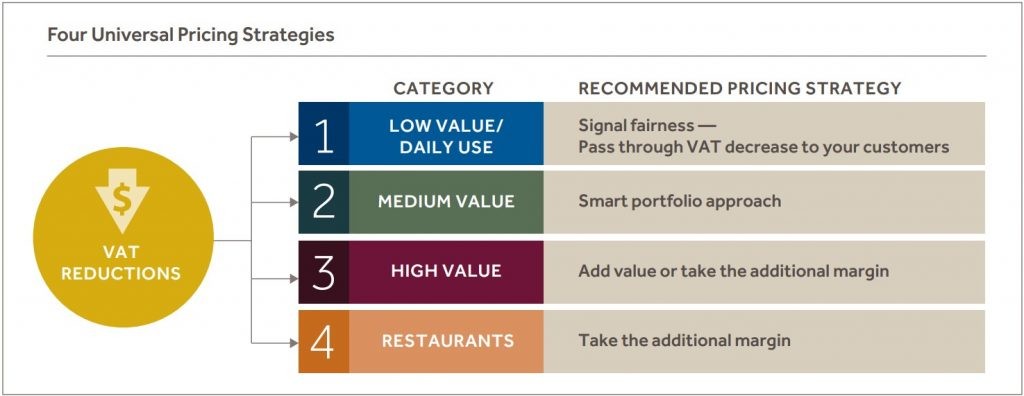Four Pricing Strategies to Navigate the Upcoming VAT Decrease in Germany
Pricing in COVID-19 times is a tricky issue. Demand patterns are unclear, the cost to serve has dramatically increased in many cases and sectors, and revenue is hampered by supply shortages—not by demand. (Please also see Blue Ridge Partners’ Executive Briefing “Pricing in Turbulent Times”) The German government recently announced a VAT (value added tax) reduction as part of its tax relief measures to offset the corona crisis. Specifically, this means:
- Products and services taxed currently at the 19% VAT rate will be reduced to a VAT rate of 16% between July 1st and the end of the year 2020.
- The currently “reduced” VAT rate of 7% (e.g., for food) will be reduced to 5% for the same timeframe.
- Restaurants will benefit from the standard reduced VAT rate of 7%. The relief will be active from July 2020 for 12 months and will apply to all menu items except drinks.
In light of the current business environment, we are frequently asked: How should businesses adjust their pricing strategies in response to the VAT reductions? Although there is never a one-size-fits-all answer, we have developed four universal pricing strategies to guide your decision-making:

Table of Contents
1. Goods and services of daily use and relatively low value:
The key in this segment is to signal fairness. Our recommendation is to pass on the VAT decrease to your customers.
The new “VAT pass-through” prices will be easy to recognize due to the odd price points. Not passing on the tax advantage to your customers bears the risk of being perceived as an unfair practice. The negative image will stick to your brand long after VAT rates have returned to their current level. Not all customer segments will react. For lower-income households, this relatively low price decrease can trigger higher consumption and higher (net) basket sizes while the impact on mid and high-income households will be limited. In addition to passing on the lower VAT rate, we recommend companies review the new price landscape to find opportunities to adjust prices below psychological price thresholds and highly visible signal items and prices that can drive additional demand. Large German discount and retail chains have already made public announcements that they will pass on the tax advantage to their customers.
2. Goods and services of medium value:
We recommend a smart portfolio approach, selectively decreasing prices in some parts of the portfolio to drive volume and take margin in others.
Passing the reduction of 19% VAT to 16% on to your customer will only generate an effective 2,5% price decrease in the eye of the consumer (not 3%). Price reaction functions usually have an “asymmetric saddle”, which means small price changes have low to little demand impact. It takes a bigger price decrease than an increase to trigger a demand reaction. Unless a psychological price threshold is passed, a 2,5% price decrease is usually too low to drive additional demand. Analyze your portfolio and selectively adjust prices only for those products that have beneficial price elasticity and serve as signal prices. This might require reducing select prices by more than the effective 2,5% driven by the VAT decrease to move away from the inelastic saddle while keeping an eye on psychological price thresholds. Choose selected products for signal prices, communicate these price changes clearly as “temporary offers”, and keep the gross price (incl. VAT) for other products constant by increasing the net price before VAT. A variant of this strategy has been successfully applied for VAT increases in the past. Bundling and upselling provide additional opportunities to extract a willingness to pay to leverage the VAT decrease.
| EXAMPLE: The current price of an X-Box is EUR 299,99 at a large consumer electronics chain. Passing through the VAT decrease to would make the new price EUR 292,43. Would this trigger a purchase decision in favor of the X-Box? Most likely not; the price decrease is too low. A better option would be to go down to EUR 289,99 or to add a voucher to upgrade to a more expensive bundle with a game or additional controller at a slightly higher price point. |
3. High-value goods and services:
Add value or take the additional margin.
High-value items are usually subject to a longer and less impulsive buying process. In most cases, the effective price decrease of 2,5% will have no impact at all on purchasing behavior for high-value goods and services. The absolute price decrease is simply too low to trigger a purchase decision. For example, a Volkswagen Golf that costs EUR 19.900 before the VAT decrease would be priced at EUR 19.398 after the decrease—a reduction of just EUR 502. Previous government demand stimulation programs have given incentives in the order of magnitude of EUR 2.500 and even up to EUR 10.000 to incentivize car purchases. Therefore, it is better to increase customer value by adding a service package or warranty extension at a reduced price—adding value in a bundle—or simply to take the additional margin.
4. Restaurants:
Take the margin. Restaurants will not drive significant traffic with price reductions.
Restaurants will temporarily benefit from the same reduced VAT rates of 7% as take-out food and delivery services. Passing through the VAT decrease from 19% to 7% means an effective gross price decrease for the consumer of 10%. This looks good at first sight. Unfortunately for restaurants, there are stronger purchase barriers than prices at the moment. If your guests are resistant to taking their family to dine out because of health concerns, lowering the price of a Schnitzel from EUR 13,90 to EUR 12,50 will not make them change their decision but it will leave a margin on the table. Restaurants also have to fight capacity constraints that put a high burden on their profitability and liquidity. In these cases, it can be considered absolutely fair to take the margin from VAT decreases to support your business. As a matter of fact, you might have to think about additional smart price increase measures.
Prepare for the return to standard VAT rates (your return strategy):
The strategy for returning to pre-reduced VAT prices is even more important than your pricing strategy for the next six to 12 months. Any price decrease decision based on the tax relief program must include a way back that avoids adversely impacting your brand image. Do not contaminate your long-term profitability or make price moves that could trigger competitive reactions—or even price wars. It will be relatively easy to return to the old VAT rates if you simply pass through the VAT decrease. If you choose a smart portfolio approach, make sure you communicate that the lower prices are discounts and are temporary. Also be aware that adding another price increase to the VAT-based price increase on Jan 1st, 2021 might be perceived as excessive. Consider adjusting your price increase schedule either before the year end or later in 2021.
Summary
Done right, the VAT change can be used to drive profit in your business in the short term; done wrong, there are significant downside risks (e.g., alienating customers and contaminating long-term profitability). There is no one-size-fits-all strategy and the specifics of your business and market need to be considered. Based on these four universal strategies, business and pricing leaders have a pragmatic starting point to think about their strategic options.


